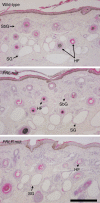Functionally reciprocal mutations of the prolactin signalling pathway define hairy and slick cattle
- PMID: 25519203
- PMCID: PMC4284646
- DOI: 10.1038/ncomms6861
Functionally reciprocal mutations of the prolactin signalling pathway define hairy and slick cattle
Abstract
Lactation, hair development and homeothermy are characteristic evolutionary features that define mammals from other vertebrate species. Here we describe the discovery of two autosomal dominant mutations with antagonistic, pleiotropic effects on all three of these biological processes, mediated through the prolactin signalling pathway. Most conspicuously, mutations in prolactin (PRL) and its receptor (PRLR) have an impact on thermoregulation and hair morphology phenotypes, giving prominence to this pathway outside of its classical roles in lactation.
Conflict of interest statement
M.D.L., K.T., T.J., C.H., T.L., R.G.S., R.J.S. and S.R.D. are employees of Livestock Improvement Corporation, a commercial provider of bovine germplasm. The remaining authors declare no competing financial interests.
Figures





References
-
- Oftedal O. T. & Dhouailly D. Evo-devo of the mammary gland. J. Mammary Gland Biol. Neoplasia 18, 105–120 (2013). - PubMed
-
- Bocchinfuso W. P. et al.. Induction of mammary gland development in estrogen receptor-alpha knockout mice. Endocrinology 141, 2982–2994 (2000). - PubMed
-
- Kondo S., Hozumi Y. & Aso K. Organ culture of human scalp hair follicles: effect of testosterone and oestrogen on hair growth. Arch. Dermatol. Res. 282, 442–445 (1990). - PubMed
Publication types
MeSH terms
Substances
Associated data
LinkOut - more resources
Full Text Sources
Other Literature Sources

